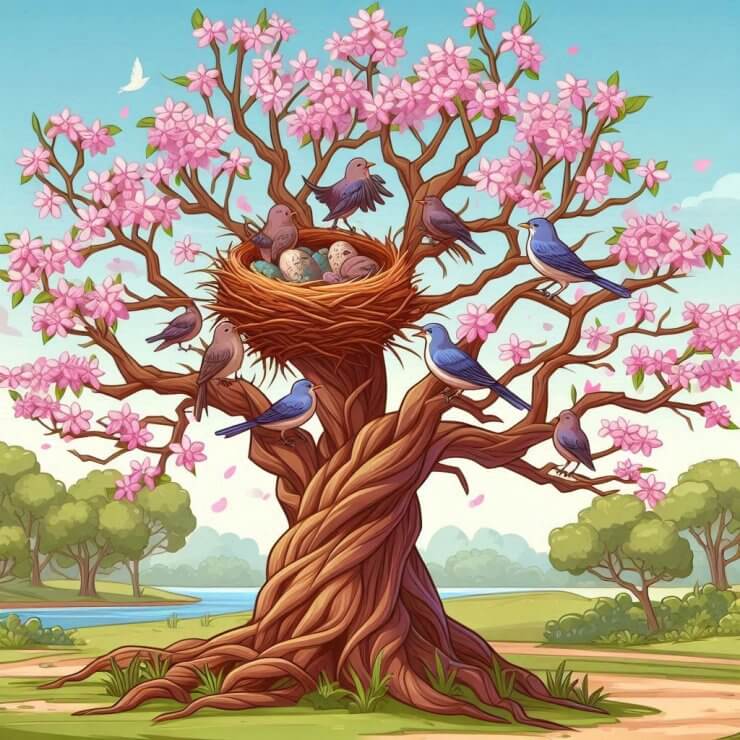Read by Michael Flamel

The old Catalpa tree was a haven for the birds each Spring. As its leaves grew, songbirds established their nests, hidden among the Catalpa’s floppy green foliage. The nestlings, though invisible, made their presence known with constant chirping while their parents frequently brought food. April often brought a few warm, sunny days, perfect for sitting outside and enjoying the melodic cries of the baby birds nestled in the Catalpa’s canopy.
The old Catalpa was also a playground for children, particularly boys around nine or ten, who couldn’t resist climbing its trunk. Starting from a large bump, they ascended to a natural platform where the main branches began. Over time, weeds grew in these nooks, and a neighborhood raccoon left its mark. Despite holes made by woodpeckers, the old tree continued to thrive year after year. Its jasmine-scented flowers bloomed late, and when a July windstorm hit, the white blossoms fell en masse, covering the grass like Summer snow. Positioned between the house and the afternoon sun, the Catalpa acted as a natural air conditioner, providing much-needed shade during the hottest months.
However, come November and December, the Catalpa dropped its leaves, creating a mess that required raking. This chore, though tiresome, forced us outside for some exercise during the cold, wet Autumn days.
One day, while mowing the lawn with the John Deere, I heard a loud crash from the other side of the house. Rushing over, I found that the Catalpa’s largest branch had sheared off, bringing down several others with it. Surprisingly, the most vulnerable spots, hollowed out by woodpeckers, remained intact. It was clear the tree was now a hazard, and we were fortunate it hadn’t fallen on anyone. Although we loved that tree, we had ignored its gradual decay. With heavy hearts, we decided to remove it. We were so sorry to see it go that we paid a considerable amount to the local nursery for a new Catalpa, which we planted as close as possible to where the old one had stood.
The old Catalpa transformed our yard from a barren space into a lively, beautiful environment, providing a home for birds, a playground for children, and cooling shade for our house. Without it, the yard felt empty, even after we planted the new tree. We knew it would take years for the new Catalpa to match the old one’s grandeur.
In our culture, youthful vitality is often celebrated, and old age is seen as a liability. This perspective is mistaken. While it’s true that we physically weaken and decay with age, our old Catalpa was at its most majestic and beneficial in its later years. Though its branches had weakened and its days were numbered, the soul of the tree and what it contributed to the environment, grew richer and more valuable each year until it finally fell.
The sages of the Talmud tell a story of an old man planting a tree. A young man questioned why he was planting a carob tree, knowing it takes 70 years to bear fruit. The old man replied, “Just as others planted for me, I plant for future generations.”
No matter how diseased and hollow the old Catalpa became, each Spring it sought nourishment and grew anew, dignified and beautiful. As we age, we need not retire from meaningful pursuits. Though it may hurt our arthritic necks to pull weeds, we know what, where, and when to plant. We know how to grow our gardens better each year, and we finally have more time to engage in priceless activities. Like the Catalpa’s leaves seeking the sun, we seek relevance.
We may find seedlings from our trees scattered in our gardens. Rather than treating them as weeds, let’s nurture them in pots. After a year or two of care, we can plant them in the yard or give them to someone who knows where they should go. Additionally, we can take cuttings from our Catalpas and rhododendrons, dip them in root hormone, and gently pot them. With proper care, by Spring we will have new trees and shrubs ready to beautify a yard, please the eye, create a playground, provide a habitat for living creatures, and transform the barren into the cultivated. ❖
About the Author: Andy Becker, known as “The Spiritual Gardener,” blends his passion for horticulture with deep spiritual insights. He shares his love for nature and wisdom through his writing, encouraging others to find peace and purpose in their gardens. Andy lives in a quaint cottage where he tends to his beloved plants, always looking to plant seeds for future generations.


 Previous
Previous


Lovely story! Thank you. More please.